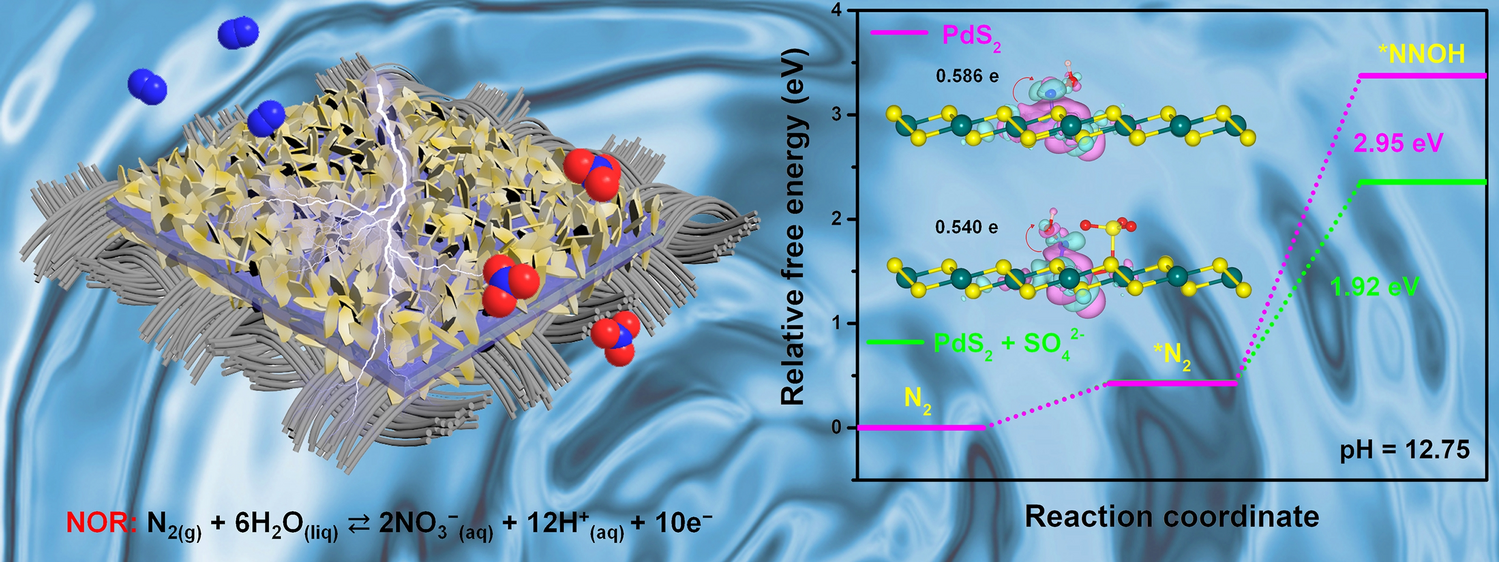In Situ Generated Sulfate-Facilitated Efficient Nitrate Electrosynthesis on 2D PdS2 with Unique Imitating Growth Feature

Electrocatalytic nitrogen oxidation (NOR)—the green alternative to the century-old, energy-guzzling Ostwald process—has long been stifled by the formidable 941 kJ mol-1 N≡N bond and the relentless competition from oxygen evolution. In a breakthrough review published in Nano-Micro Letters, researchers from Liaoning University and RMIT University, led by Professors Hui Mao and Tianyi Ma, demonstrate how interface-engineered 2D PdS2 nanoplates decisively overcome both hurdles, delivering record nitrate yields with unprecedented stability.
Why PdS2 Now Matters
- Imitating-Growth Morphology: PdS2 “copies” the topography of its 2D substrate. Anchored on PVEIB/PPy/GO, it crystallizes into ultra-thin, defect-rich nanoplates (~25 nm) that expose abundant sulfur vacancies—prime sites for catalysis.
- Self-Generating Sulfate: Those same vacancies spontaneously oxidize to SO42- during synthesis or at high anodic potentials. This in-situ sulfate slashes the activation energy of the rate-limiting N2→*NNOH step from 2.95 eV to 1.92 eV, a 35 % cut that outperforms state-of-the-art Ru-doped oxides.
- Triple Synergy: GO supplies a vast surface, PPy accelerates electron transport, and PVEIB imidazolium groups sterically confine growth—yielding a composite with 9 µg h-1 mg-1 nitrate productivity and 7.36 % Faradaic efficiency at only 2.05 V vs RHE.
Enduring Performance Under Harsh Conditions
- 30-hour Continuous Electrolysis: No decay in current or crystal structure, verified by post-mortem TEM and synchrotron HERFD-XANES.
- Six-Cycle Stress Test: >95 % activity retained, versus >80 % loss for bare PdS2.
- 100 % Selectivity: Ion chromatography detects only NO3-—zero NO2-, NH3, or gaseous by-products.
Mechanistic Insight: Sulfate as the Silent Co-Catalyst
Real-time ATR-SEIRAS captures the ascent of bridging bidentate nitrate peaks (1245 & 1646 cm-1) that mirror anodic current, confirming an associative distal pathway. DFT charge-density maps reveal that SO42- modulates electron donation from Pd to *NNOH, weakening the N–N bond and accelerating turnover. Electrochemical impedance collapses from 2.7 kΩ to 310 Ω, underscoring faster interfacial charge transfer.
Future Outlook
The imitating-growth protocol is substrate-agnostic—ready to be ported to MXene, g-C3N4, or other novel TMDs. Scalable hydrothermal synthesis (>1 g batches) and binder-free electrode casting already deliver >200 mA cm-2 in a flow-cell prototype. Coupled with renewable electricity, this sulfate-coupled platform could decentralize nitrate production, cutting CO2 emissions from the Ostwald process by more than 70 %. Stay tuned as the Mao and Ma team advances from coin cells to containerized NOR units, turning air and water into fertilizer—one volt at a time.
Follow the Topic
-
Nano-Micro Letters

Nano-Micro Letters is a peer-reviewed, international, interdisciplinary and open-access journal that focus on science, experiments, engineering, technologies and applications of nano- or microscale structure and system in physics, chemistry, biology, material science, and pharmacy.






Please sign in or register for FREE
If you are a registered user on Research Communities by Springer Nature, please sign in